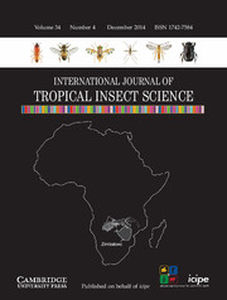Article contents
Integrated Management of Stemborers of Sorghum and Pearl Millet
Published online by Cambridge University Press: 19 September 2011
Abstract
Several species of stemborers attack sorghum and pearl millet in Africa and Asia. The commonest species on sorghum are Chilo partellus (Swinhoe) and Busseola fusca (Fuller) and on pearl millet, Contesta ignefusalis (Hampson). This paper discusses control options and the extent to which farmer perceptions of stemborers and associated crop losses have been considered. Examples of research aimed at developing IPM strategies are presented in the context of their impact or lack of it, on the farming community. Research efforts have traditionally focused on the development of resistant cultivare and only recently are they being targeted towards a combination with cultural and biological tactics. Conventional breeding procedures have not produced adequate levels of resistance to stemborers and natural enemies are not effective in regulating borer populations. The prospects of applied biological control and improved intercropping configurations are discussed. Reference is also made to progress in the role of semiochemicals in parasitoid activity on Ch. partellus and sex pheromones in the control of Con. ignefusalis. Unless resistance levels to stemborers are increased through biotechnological approaches, optimisation of the yield potential in existing cultivars requires that IPM research should focus on the improvement of cultural and biological components and should incorporate farmers' perceptions and an assessment of traditional pest management practices.
Résumé
Plusiers espèces de foreurs de tiges attaquent le sorgho et le petit mil en Afrique et en Asie. Les espèces les plus commones dans le cas du sorgho sont Chilo partellus (Swinhoe) et Busseola fusca (Fuller) et dans le cas du petit mil, Coniesta ignefusalis (Hampson). Le présent document discute des options de contrôle, et de la mesure dans laquelle les perceptions que les agriculteurs ont des foreurs de tiges et des pertes de cultures associées ont été prises en compte. Des exemples de recherche visant à élaborer des stratégies de lutte intégrée sont présentés dans le contexte de leur impact sur la communauté agricole ou en son absence. Les efforts de recherche ont par le passé été axés sur la mise au point de variétés résistants et c'est seulement récemment qu'ils ont été orientés vers une combinaison d'approches culturelles et biologiques. Les procédures conventionnelles de sélection n'ont pas suscité des niveaux adéquats de résistance aux foreurs de tiges, et les ennemis naturels ne sont pas plus en mesure de réguler les populations de foreurs de tiges. Les perspectives du contrôle biologique appliqué et des configurations inter-cultures améliorées font l'objet de discussion. Référence est également faite au progrès réalisé dans le rôle des produits semio-chimiques dans les activités parasitoïdes sur le Ch. partellus et les phéromones du sexe dans la lutte contre Con. ignefusalis. A moins que les niveaux de résistance aux foreurs de tiges ne soient accrus par le biais d'approches biotechnologiques, l'optimisation du potentiel de rendement dans les variétés existants nécessite que la recherche en matière de lutte intégrée soit axée sur l'amélioration des composantes culturelles et biologiques et devraient inclure les perceptions des agriculteurs et une évaluation des pratiques traditionnelles de luttes contre les déprédateurs.
Keywords
- Type
- Articles
- Information
- Copyright
- Copyright © ICIPE 1997
References
REFERENCES
- 3
- Cited by


